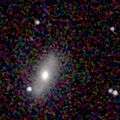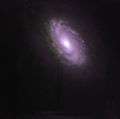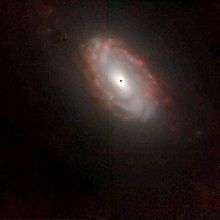NGC 23
| NGC 23 | |
|---|---|
|
NGC 23 by HST | |
| Observation data (J 2000.0 epoch) | |
| Constellation | Pegasus |
| Right ascension | 00h 09m 53.4s |
| Declination | +25° 55′ 27″ |
| Redshift | 0.015231[1] |
| Helio radial velocity | 4566 ± 2 km/s[1] |
| Distance |
193 ± 14.6 Mly (59.2 ± 4.5 Mpc)[2] |
| Apparent magnitude (V) | 11,9 mag |
| Characteristics | |
| Type | SB(s)a;HII; LIRGSbrst |
| Apparent size (V) | 1,9′ × 1,4′ |
| Other designations | |
| UGC 89, PGC 698, GC 9.[1] | |
NGC 23 is a spiral galaxy located in the Pegasus constellation.
In the Webb Society Deep-Sky Observer's Handbook, [3] the visual appearance of NGC 23 is described as follows:
Bright, extended ellipse; a bright nuclear structure is noticeably elongated; two weak spiral enhancements emerge from opposite sides of the nucleus, one curving towards a bright star attached on the south end. The galaxy is likely interacting with NGC 9.
Gallery


 Hubble (optical)
Hubble (optical)
References
- 1 2 3 "NASA/IPAC Extragalactic Database". Results for NGC 0023. Retrieved 2010-05-04.
- ↑ "Distance Results for NGC 0023". NASA/IPAC Extragalactic Database. Retrieved 2010-05-04.
- ↑ Jones, K. G. (1981). Webb Society Deep-Sky Observer's Handbook. Enslow Publishers. ISBN 0894901346.
External links
- NGC 23 on WikiSky: DSS2, SDSS, GALEX, IRAS, Hydrogen α, X-Ray, Astrophoto, Sky Map, Articles and images
This article is issued from Wikipedia - version of the 11/12/2016. The text is available under the Creative Commons Attribution/Share Alike but additional terms may apply for the media files.
